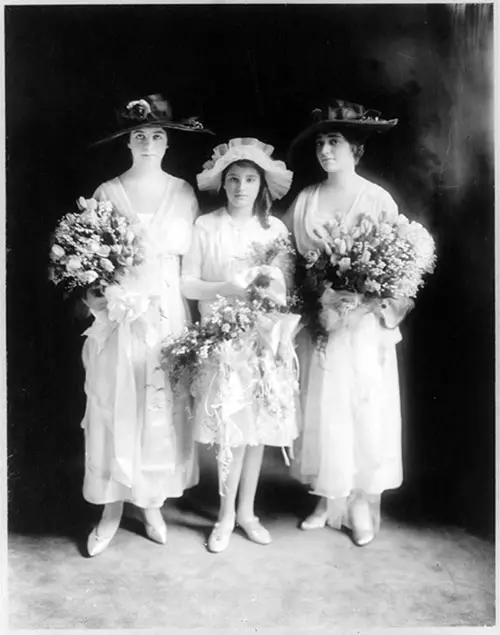Advice for Bridesmaids’ Gowns and Accessories - 1910

Hardly less in importance to the question of the bride’s attire, no less certainly when the picturesque effect of the processional is considered, is the question of the bridesmaids’ gowns. For here selection must make or mar the picture.
A maid-of-honor or bridesmaid, having accepted the honor conferred upon her by being chosen to take part in the ceremonial, should spare neither effort nor expense to please the bride and add to the beauty of the occasion.
She should consult invariably with the bride about the color and style of her gown and should fully follow the bride’s wishes. Very often the bride, having outlined her choice of color scheme, asks her maids to agree among themselves as to the distribution of colors and secondary effects.
As a rule, the maid-of-honor wears a distinctive gown of some pale color to harmonize with the general color scheme, or she may wear a white dress with colored sash, or over a colored slip, while bridesmaids have sashes of white, the sashes being adjusted with either a twist or loops, and with long ends.
Many beautiful materials may be used for these creations, some of which are inexpensive. Chiffon cloth, soft silks, louisine, and crépe de chine are most favored.
When the wedding is pink, green, and white one, for instance, the maid-of-honor usually wears a gown of the solid color, while the maids-of-honor wear frocks of white over the color, or white with colored sashes. They may wear veils reaching to the waist, adjusted to the head with a large bow.
These veils are pale pink or yellow or green, matching the gowns with which they are to be worn. The bows that adjust the veils may be of tulle, or of cloth of silver or fabric of gold.
Shirred mull muffs or chiffon parasols to match the color scheme are carried by bridesmaids sometimes instead of flowers, Baskets of flowers are sometimes swung from the arms by wide ribbons.
Wreaths may be worn in the hair or half garlands of small flowers. Sometimes these are worn, confining the short veil. Alternatively, ostrich tips may be worn, either with or without the veil.
There should be no haphazard choice about these gowns which are to be worn in such juxtaposition. Bridesmaids’ toilettes must be planned concerning the style of the bride’s dress and in deference to whatever ideas she may have about the costuming of the chosen friends whom she wants to have about her.
Of course, a bride would not willingly inflict an unbecoming style or color upon a bridesmaid, but she may choose the colors which she desires grouped, and her maids are not supposed to object.
Complexions and the effects of specific tints upon them are considered before an unalterable decision is made. It is not good taste for some of the maids to wear trained and others gowns of walking length.
The bridesmaids may be many or few, but the color of the dresses should be most carefully chosen, that there may be no discord.
According to fancy, the bridesmaids’ dresses may be white or all one pale color. If they are equally divided between blondes and brunettes, two harmonizing colors may very delightfully be used.
It is customary for the maids to provide their gowns. Now and then a bride, who has no limits to her expenditures may, if she wishes, supply the entire outfit of her maids. However, this is in no sense obligatory upon any bride and is overall but seldom done.
In any case, however, it is customary for the bride to provide her maids with the gloves they wear, and with the bouquets, baskets of flowers, or whatever they carry.
In addition to this, she usually bestows, at her bridal luncheon to them if she gives one, or at the rehearsal, small souvenirs in the way of pins, brooches or other little trinkets.
A pretty fashion is to carry gold or silver purses, and in this case, these are usually the flavors presented by the bride to her maids at the bride’s luncheon given before the wedding.
One of the prettiest weddings ever planned was where the bride was preceded by about twenty of her girlfriends—in fact, almost the entire personnel of her particular set—all wearing some pretty evening dress which had been previously worn, and singing, as they entered, the wedding march from Lohengrin.
This is especially good when the bride is a member of some choral society and is an excellent way of solving this particular problem of the selection of bridesmaids, and no annoying choice had to be made—all felt that they had participated equally in the ceremonial which ushered their friend into her happiness.
Another excellent feature was the fact that no one was obliged to incur any unusual expense in the purchase of a gown, and the spectacular features of the affair were incredibly charming. At a church wedding, the bridesmaids usually wear large picture hats or veils, while for a home wedding no hats need to be worn.
Clark, Jean Wilde, Ed., Weddings and Wedding Anniversaries: The Bridesmaids’ Gowns and Accessories, New York, The Butterick Publishing Company, 1910, p. 26-28. Image from Library of Congress.
Note: We have edited this text to correct grammatical errors and improve word choice to clarify the article for today’s readers. Changes made are typically minor, and we often left passive text “as is.” Those who need to quote the article directly should verify any changes by reviewing the original material.

